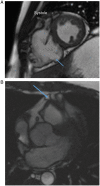Diagnostic and therapeutic strategies for arrhythmogenic right ventricular dysplasia/cardiomyopathy patient
- PMID: 29688316
- PMCID: PMC6321962
- DOI: 10.1093/europace/euy063
Diagnostic and therapeutic strategies for arrhythmogenic right ventricular dysplasia/cardiomyopathy patient
Abstract
Arrhythmogenic right ventricular dysplasia/cardiomyopathy (ARVD/C) is a rare inherited heart muscle disease characterized by ventricular tachyarrhythmia, predominant right ventricular dysfunction, and sudden cardiac death. Its pathophysiology involves close interaction between genetic mutations and exposure to physical activity. Mutations in genes encoding desmosomal protein are the most common genetic basis. Genetic testing plays important roles in diagnosis and screening of family members. Syncope, palpitation, and lightheadedness are the most common symptoms. The 2010 Task Force Criteria is the standard for diagnosis today. Implantation of a defibrillator in high-risk patients is the only therapy that provides adequate protection against sudden death. Selection of patients who are best candidates for defibrillator implantation is challenging. Exercise restriction is critical in affected individuals and at-risk family members. Antiarrhythmic drugs and ventricular tachycardia ablation are valuable but palliative components of the management. This review focuses on the current diagnostic and therapeutic strategies in ARVD/C and outlines the future area of development in this field.
Figures





References
-
- Marcus FI, Fontaine GH, Guiraudon G, Frank R, Laurenceau JL, Malergue C. et al. Right ventricular dysplasia: a report of 24 adult cases. Circulation 1982;65:384–98. - PubMed
-
- Sosman MC. The Disorders of Cardiac Rhythm. Oxford and Edinburgh: Blackwell; 1971.
-
- Fontaine G, Guiraudon G, Frank R, Vedel J, Grosgogeat Y, Cabrol C. et al. Reentrant Arrhythmias. Lancaster: MTP; 1977.
-
- Sen-Chowdhry S, Syrris P, Ward D, Asimaki A, Sevdalis E, McKenna WJ.. Clinical and genetic characterization of families with arrhythmogenic right ventricular dysplasia/cardiomyopathy provides novel insights into patterns of disease expression. Circulation 2007;115:1710–20. - PubMed
Publication types
MeSH terms
Substances
LinkOut - more resources
Full Text Sources
Other Literature Sources
Medical

